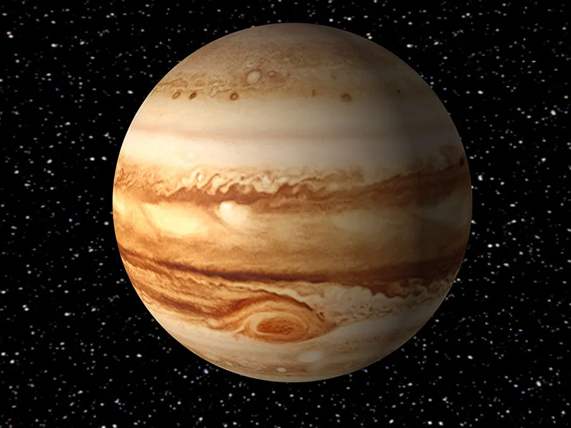Jupitar
Jupiter or Sol V is the fifth planet from the Sun and the largest in the Solar System. It is a gas giant with a mass more than two and a half times that of all the other planets in the Solar System combined, and slightly less than one one-thousandth the mass of the Sun. It is orbiting the Sun at a distance of 5.20 AU (778.5 Gm) with an orbital period of 11.86 years. Jupiter is the third brightest natural object in the Earth's night sky after the Moon and Venus, and it has been observed since prehistoric times. It was named after Jupiter, the chief deity of ancient Roman religion.
This was the first planet to form, and the inward migration of Jupiter during the primordial Solar System impacted much of the formation history of the other planets. Jupiter is primarily composed of hydrogen (90% by volume), followed by helium, which constitutes a quarter of its mass and a tenth of its volume. The ongoing contraction of Jupiter's interior generates more heat than the planet receives from the Sun. Its internal structure is believed to comprise an outer mantle of liquid metallic hydrogen, and a diffuse inner core of denser material. Because of its rapid rotation rate of 1 rotation per 10 hours, the planet's shape is an oblate spheroid: it has a slight but noticeable bulge around the equator. The outer atmosphere is divided into a series of latitudinal bands, with turbulence and storms along their interacting boundaries. The most obvious result of this is the Great Red Spot, a giant storm which has been observed since 1831 and possibly earlier.
Jupiter is surrounded by a faint planetary ring system and has a powerful magnetosphere, the largest contiguous structure in the Solar System after the heliosphere. Jupiter forms a system of 195 known moons, including the four large moons discovered by Galileo Galilei in 1610: Io, Europa, Ganymede, and Callisto. Ganymede, the largest of the four, is larger than the planet Mercury. Callisto is the second largest; Io and Europa are approximately the size of Earth's Moon.
Overview
[coming soon]History
Rise of Humanity
Humans began colonizing Jupiter's moons in the mid-to-late 2060s. The planet itself was settled by gas mining operations and industrial habitat orbital stations. Many of the station habitats were founded to serve as waystations for resource extraction further out in the solar system.Second Nuclear War
[coming soon]Jovian Conflict of 2687
[coming soon]Second Energy War
[coming soon]Jupiter
Astrographical
System Sol system
Orbiting Sol
Orbital position Fifth planet
Moon(s) 195; including Io, Europa, Ganymede, and Callisto
Physical
Mean radius 69,911 km (43,441 mi)
Mass 1.8982×1027 kg (4.1848×1027 lb) 317.8 of Earth's, 1/1047 of Sun's
Mean density 1,326 kg/m3 (2,235 lb/cu yd)
Surface gravity 24.79 m/s2 (81.3 ft/s2) 2.528 g
Temperature 88 K (−185 °C) (blackbody temperature)
Societal
Race Human (non-native)
Demonym Jovian
Government- United Nations Federation (main)
- New Soviet Union




Comments